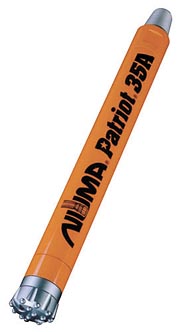
Several years ago, my drilling expertise and preference was mud rotary drilling. Once I was introduced to DHH drilling, I wondered why anyone would use anything else, unless they are drilling in sand, clays and other unconsolidated formations.
Many of my jobs in developing countries could go along much faster with the DHH method, as it is much faster and easier. However, speed isn't an issue in developing countries - cost is. Cable tool drilling still is the preferred method in hard formations in developing countries. Compressed air is costly; high-pressure air is even costlier. Today's accepted standards in the United States are bigger and faster.
There are many types of hammer bits. Since drillers have their own preferences, I recommend you find the one that fits your needs best. Personally, I like the flat-bottom bits for most drilling. Unlike roller cone bits, DHH drilling requires much less down pressure; in fact, after a point, you must hold back pressure. Rotation must be only fast enough to ensure the bit buttons impact a new spot with each cycle. The rotation is about right if the return cuttings are large. If they are small, or if you are getting lots of powder return, it can mean you are rotating the bit too slowly.
Even though today's DHHs require little or no oil, I recommend using an oilier of some type. In most cases, to keep down dust, it is best to inject water. Sometimes drill foam is helpful if you are having a problem with lack of air volume or cuttings' lift. I like using an oilier, water and foam when possible.
Of course, always wear proper work gear, such as steel-toed boots, gloves, hardhat, eye goggles, and noise protection for the ears, for all personnel working close to the drill. I found that it's best to wear shirts with no pockets or pockets with button down flaps. If you don't, your pockets will fill with dust and cuttings, and your wife and washing machine don't like that. Don't carry your billfold, palm pilot or even wear your good eyeglasses on your person while drilling with air. Dust tends to get into everything. It eventually will scratch your credit cards and eyeglasses to the point they are useless. I even found it helpful to wear un-cuffed pants and tape or band them to keep out dust. If there are other vehicles nearby, keep all windows closed.
Always be aware of the hole unloading a surge of water after making a connection or when the hole sets overnight. I usually allow the hole to unload slowly and even then, I have had the hole discharge with such force that it will blow the table bushings into the air and sometimes blow the diverter off the casing.
The use of a proper diverter always is helpful. It allows for a much cleaner machine and well site. It diverts the dust, water and foam away from the hole. If you use a diverter hose, be sure to secure the end, as it will fly around and shoot the discharge to some unwanted place or hurt someone. Be sure to contain your cuttings, foam and water and divert them away from others' property.
If you are just getting into air drilling, I recommend you contract a qualified consultant to assist you with the first few days of your drilling. I guarantee it will save you a lot of headaches and dollars.
ND

Report Abusive Comment